Key takeaways:
- Understanding and addressing miscommunication and differing expectations is crucial for project success.
- User feedback should be prioritized to avoid creating designs that do not meet user needs.
- Embracing failures as learning opportunities can lead to innovation and improved processes.
- Establishing clear communication and maintaining a structured approach to timelines enhances overall project outcomes.
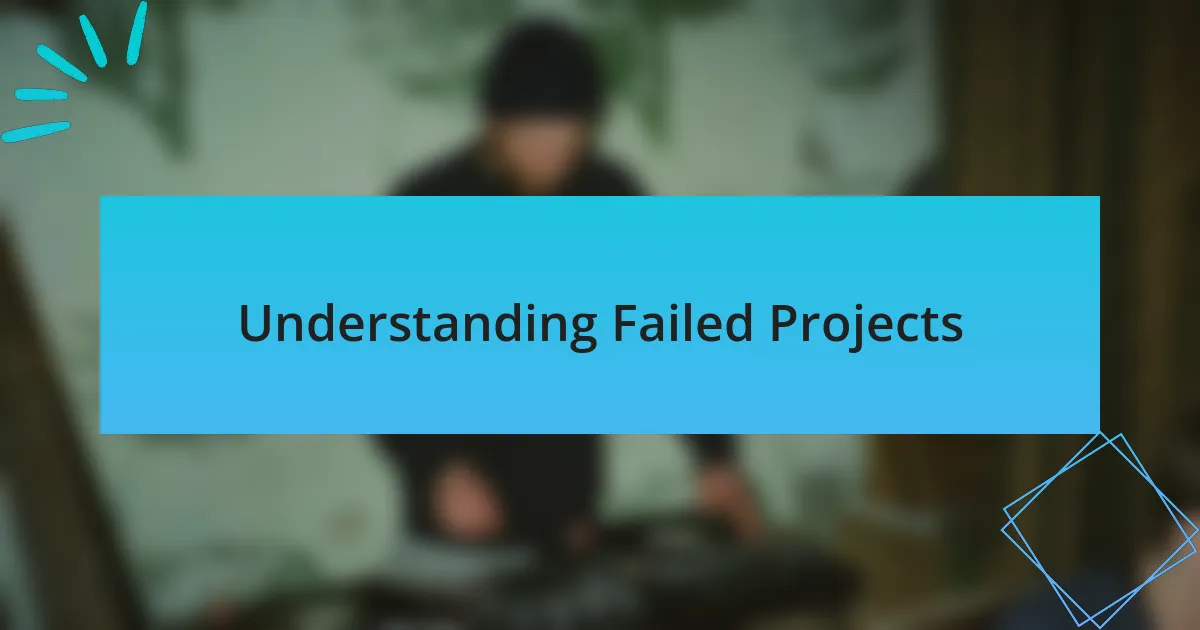
Understanding Failed Projects
Understanding failed projects is essential for growth in any design agency. I remember a project where we poured our hearts into creating a sleek website, only to discover the client had a different vision altogether. It felt like running in place; we were exhausted, but the finish line just kept moving away.
In my experience, failure often serves as a teacher, albeit a tough one. After a campaign flopped, I found myself questioning not just the design elements, but our communication with the client. Was I truly listening to their needs, or was I too wrapped up in my own ideas? These reflections opened my eyes to the importance of clarifying expectations from the start.
Another poignant lesson came from a redesign that missed the mark because we neglected user feedback. I vividly recall hearing from users who found our navigation confusing; their frustration was palpable. It struck me that ignoring the end-user’s voice could lead to significant pitfalls. How often do we risk losing sight of the user in pursuit of creativity? Recognizing this can dramatically reshape how we approach future projects.
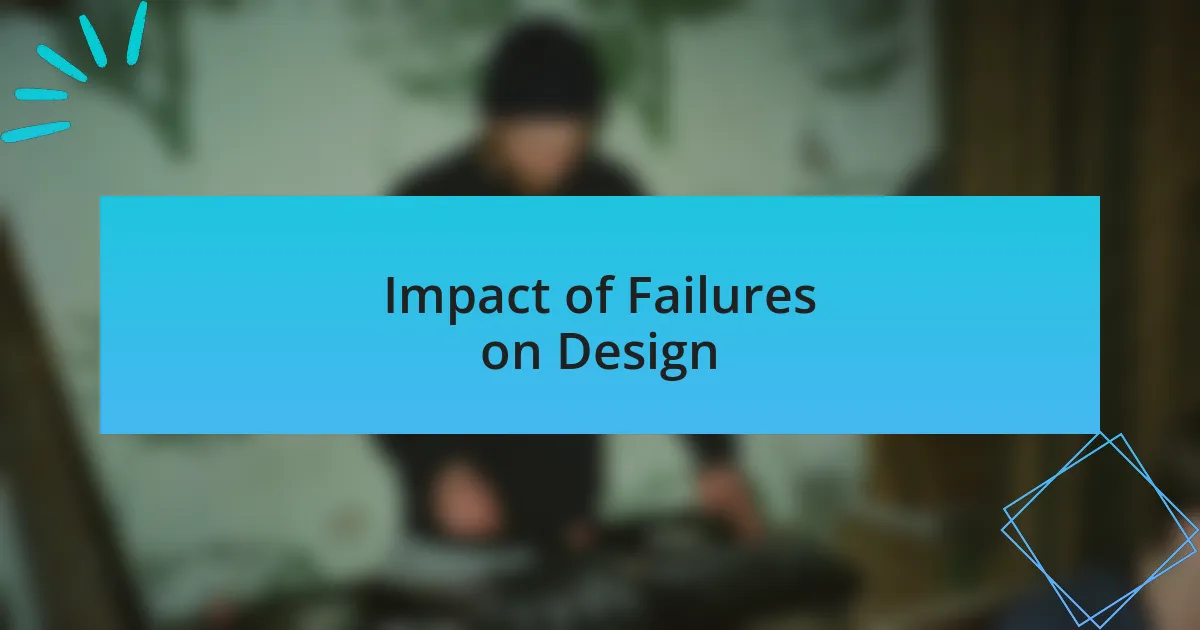
Impact of Failures on Design
The impact of failures on design can be profound, often forcing us to rethink our entire approach. During one project, we aimed for a minimalist aesthetic, believing that simplicity would enhance user experience. However, the end result left users feeling lost, as the interface became too stripped down, revealing how our intention didn’t align with their needs. This taught me that beautiful design isn’t just about visuals; it must also serve a functional purpose, reminding me that every decision should be user-centered.
I’ve also encountered situations where failure highlighted the importance of team collaboration. I remember when my team and I had differing opinions on a layout, and instead of coming together, we each defended our ideas in isolation. The final design lacked cohesion, and it was disappointing to see our potential wasted. This experience reinforced for me that collective feedback can guide the direction of a project, fostering an environment where creativity thrives. Have you ever felt that disconnect within a team? I certainly have—and it made me realize that collaboration is not just beneficial; it’s essential.
Furthermore, failures can ignite innovation if we allow ourselves to reflect on them deeply. One instance that stands out involved a project where we missed vital deadlines, leading to a rushed product launch. The chaotic process forced us to confront how we managed our timeline and resources. In retrospect, the painful lesson became a catalyst for implementing structured workflows that streamlined our operations. How often do we need to fail to truly innovate? I’ve found that embracing discomfort can lead to breakthrough ideas and enhanced processes in future designs.
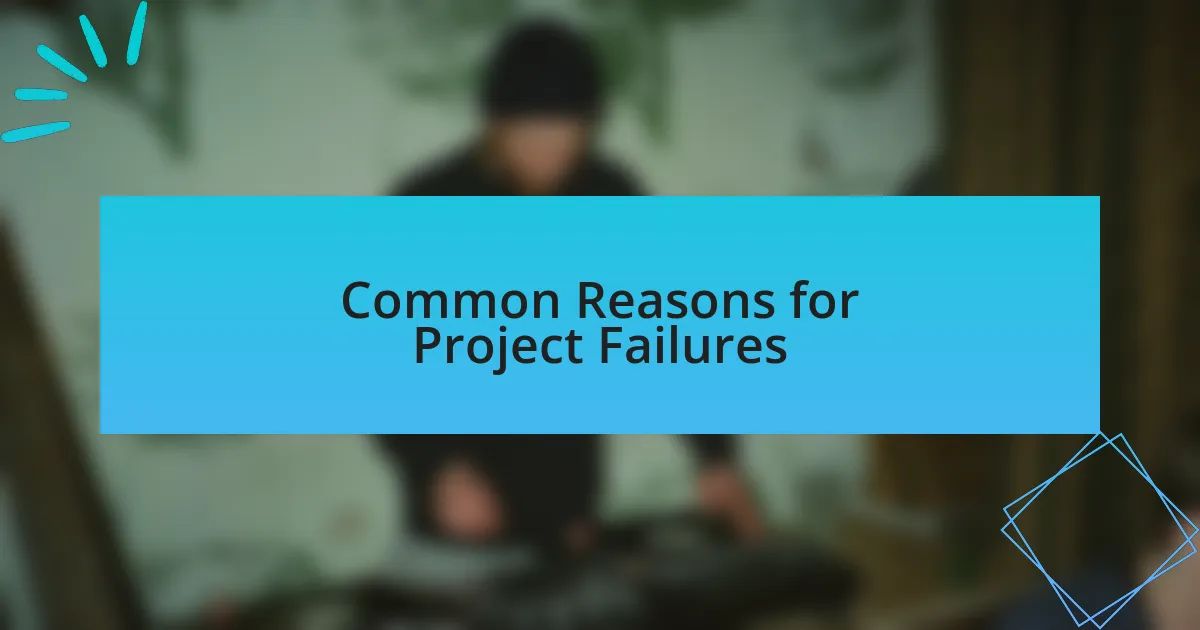
Common Reasons for Project Failures
Miscommunication is a common culprit in project failures. I remember a project where our team had assumed we were all on the same page regarding the design brief, but the expectations turned out to be vastly different. This lack of clarity led to frustration, as what we thought we were creating didn’t align with what the client envisioned. Have you ever experienced that mix-up? It’s a reminder that clear communication and regular check-ins are vital to keep everyone aligned.
Another reason I’ve encountered is scope creep, which occurs when additional features are added without proper evaluation. During one specific project, we started with a clean, focused goal, but as new ideas emerged, we kept expanding the project list. Before we knew it, the timeline had stretched, and the original vision felt diluted. It made me realize that maintaining focus is crucial—how often do we let excitement override disciplined planning?
Lastly, inadequate feedback loops can severely hinder a project’s success. In my early days, I often submitted designs without seeking input during the process. There was one time when I felt confident about a concept, only to find out later that it missed the mark entirely with users. It was a tough lesson that highlighted the importance of gathering feedback iteratively. Isn’t it fascinating how feedback can mold our designs into something truly impactful? It’s clear to me now that including stakeholders and users throughout the design journey not only minimizes risk but can dramatically elevate the final outcome.
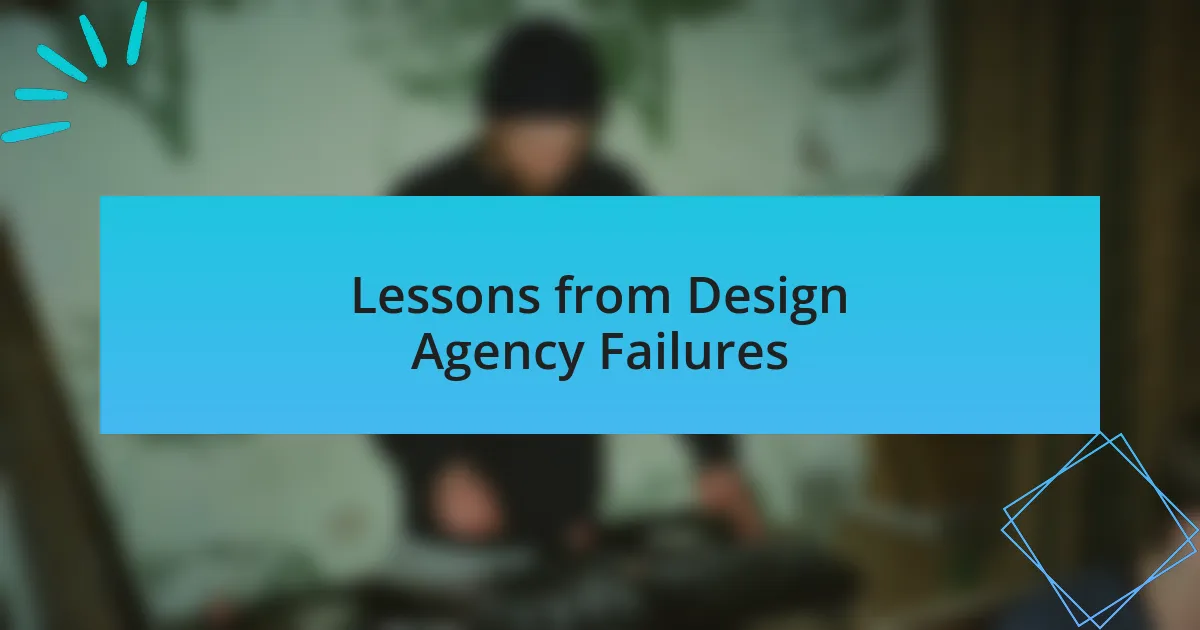
Lessons from Design Agency Failures
One of the most striking lessons I’ve learned from design agency failures is the impact of underestimating timelines. I remember a project where my team was overly optimistic about our capabilities. We set an aggressive timeline without considering potential roadblocks, thinking we could easily deliver. As days turned into weeks, the stress piled up, and creativity started to dwindle. Have you ever faced a ticking clock and felt the pressure to perform? The experience taught me to build in buffer time and respect the creative process, ensuring that quality doesn’t get sacrificed at the altar of speed.
Another critical insight revolves around the significance of user-centered design. Early in my career, I was so focused on aesthetics that I lost sight of usability. I recall designing a sleek interface that I thought looked stunning, but the user testing revealed it was frustrating to navigate. It was a painful wake-up call, emphasizing that beauty should never overshadow functionality. How often do we, as designers, get caught up in visual appeal? This failure reinforced my commitment to always prioritize the user’s experience.
Lastly, collaboration—or the lack thereof—has often shaped the outcomes of projects for better or for worse. There was a time when siloed work seemed efficient to me until I realized how isolated ideas became. I remember an instance where our marketing and development teams operated independently, leading to a final design that didn’t resonate with our audience. It struck me then that breaking down walls and fostering teamwork can lead to richer, more dynamic solutions. What if we viewed our projects through a collaborative lens? This experience taught me that unity in a design agency can transform challenges into opportunities.
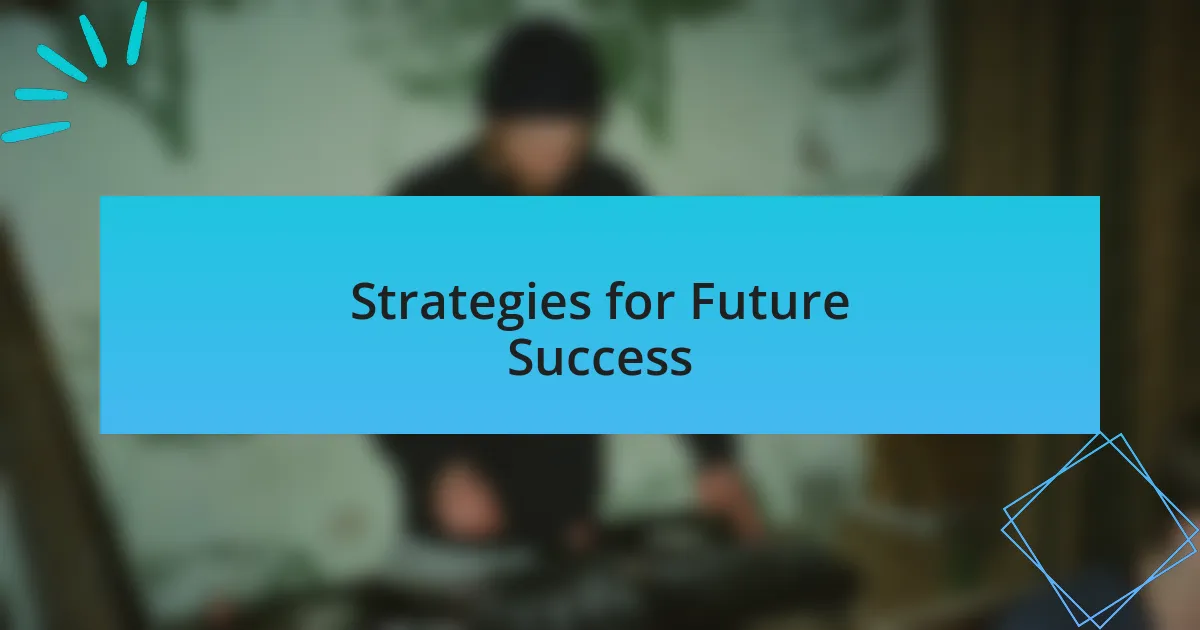
Strategies for Future Success
When it comes to strategies for future success, I’ve discovered that establishing clear communication from the start is paramount. In one project, I vividly remember the confusion that arose over role definitions and expectations. Without a transparent line of communication, team members were hesitant to voice concerns, thinking they might disrupt progress. This experience pushed me to implement regular check-ins, ensuring everyone felt heard and aligned. Have you ever felt lost in a project because the objectives were unclear? By promoting a culture of openness, I found that ideas flowed more freely, leading to greater innovation.
Additionally, I’ve learned the value of embracing failure as a learning opportunity. Once, our team faced a major setback when a client rejected a design we poured our hearts into. Initially, it felt devastating, but I soon realized that this was a chance to iterate and innovate. We gathered feedback and redefined our approach, which ultimately led to a design that exceeded the client’s expectations. How many times do we see setbacks as the end rather than the beginning? This perspective shift has become a guiding principle for me, reminding me that every failure is a stepping stone toward success.
Finally, I’ve come to appreciate the role of continual learning in design. There was a time when I assumed my skills were enough; however, I encountered a project requiring knowledge of a new design software that I was unfamiliar with. The initial panic soon turned into a drive to learn. I dove into tutorials and sought out mentorship, which not only boosted my confidence but also enriched the final outcome. This experience taught me that adapting and growing is essential in the fast-evolving world of design. Are we ready to embrace new skills, or do we cling to the familiar? Prioritizing continuous development has proven invaluable, setting me up for future successes in every project.

Personal Reflection on My Experiences
Reflecting on my journey, I can pinpoint moments that shaped my approach to design. One memorable project saw me pushing for a bold creative direction, while others hesitated, fearing it was too unconventional. This tension created an atmosphere where I felt both excitement and dread — excitement for creative potential but dread for potential failure. Ultimately, the team compromised, and despite the project’s success, I learned the importance of balancing ambition with team consensus. Have you felt the weight of a decision where you didn’t fully align with others? That moment still resonates with me, reinforcing that collaboration is as crucial as creativity.
There was another instance where I overlooked project timelines. Caught in the thrill of crafting something special, I neglected the ticking clock. The deadline approached, panic set in, and what should’ve been a celebration turned into a scramble. I remember the knot in my stomach as we rushed to finish, realizing that sometimes, the creative process needs structure. This taught me that passion must be tempered with planning. Isn’t it fascinating how time management can shape the very fabric of our creativity?
Perhaps the most poignant lesson came from a project that seemed perfect on paper but fell flat during execution. I had invested so much emotional energy into its success that its failure felt personal. I remember tearing up after a tough client meeting where the feedback was brutal yet honest. This experience stubbornly lingered, teaching me that vulnerability is part of growth. Have you ever felt your heart sink with disappointment? I realized that being emotionally invested can yield both pain and profound learning. This blend of heart and resilience is what redefines our future projects.
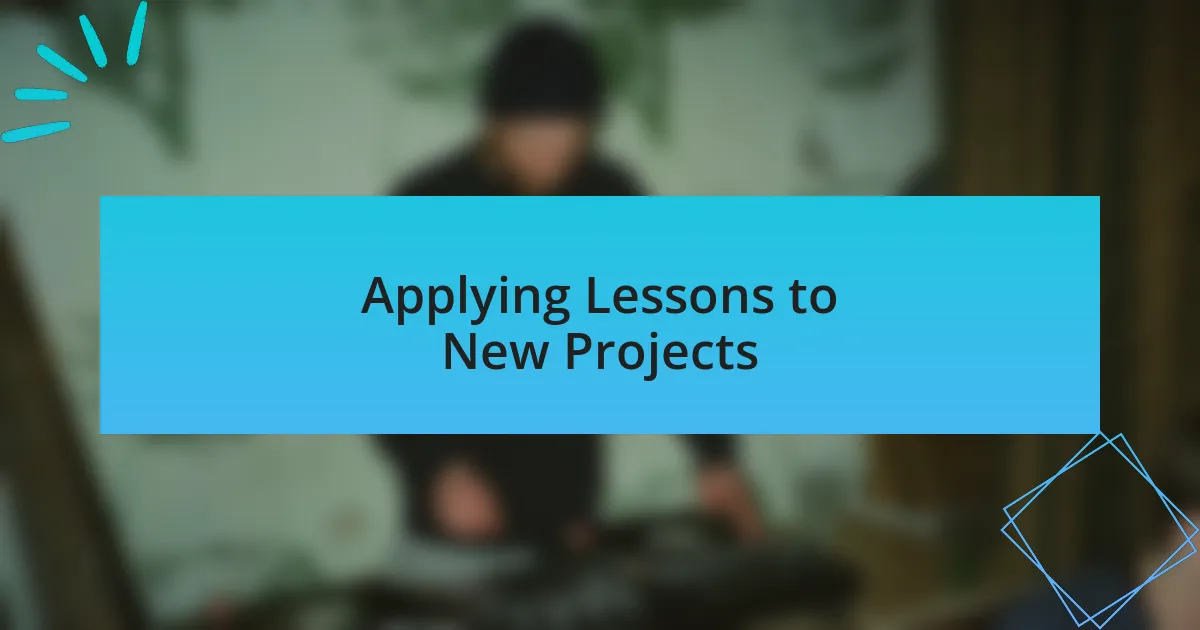
Applying Lessons to New Projects
Applying the lessons learned from previous projects profoundly influences my approach to new ones. I recall a particular experience when we failed to communicate effectively with the client, leading to frustration on both sides. This time, I make it a priority to establish clear channels of communication right from the start, ensuring everyone’s vision aligns. Have you ever faced miscommunication issues that could have been easily avoided? I now understand how critical it is to lay that groundwork.
Another lesson revolved around feedback—its value and timing. In a project where I had nearly polished the design, I hesitated to seek feedback, fearing it could derail my creative flow. However, I’ve learned that inviting constructive criticism early on can be a game-changer. I often ask myself, “What if I had welcomed input sooner?” Embracing this mindset has helped me create designs that resonate more with users and stakeholders alike; it’s about refining ideas together.
Time tracking is another practice I’ve prioritized. After a project dragged on due to poor time management, I decided to incorporate tools that help me stay on schedule. The stress that comes from rushing at the last moment is something I no longer want to experience. Instead, I aim for a sustainable pace that fosters creativity without the last-minute scramble. Doesn’t it feel rewarding to finish a project calmly and confidently? That’s the kind of workflow I strive for now, and it makes all the difference.